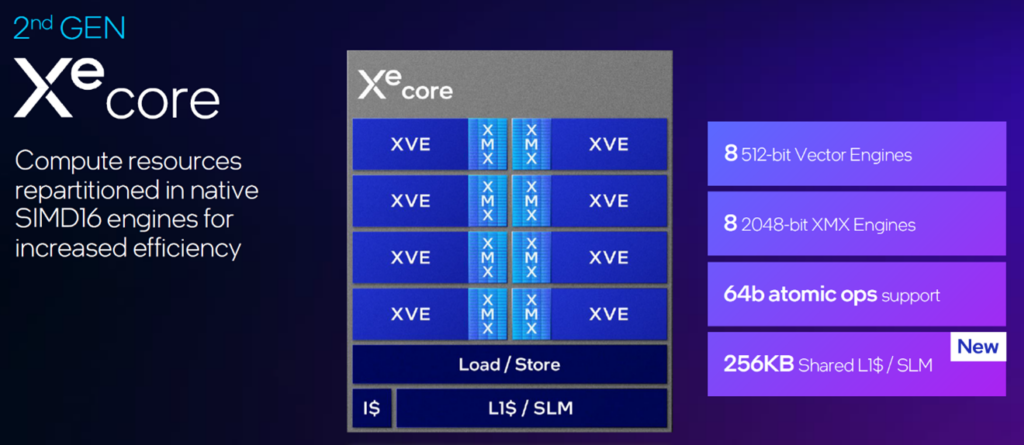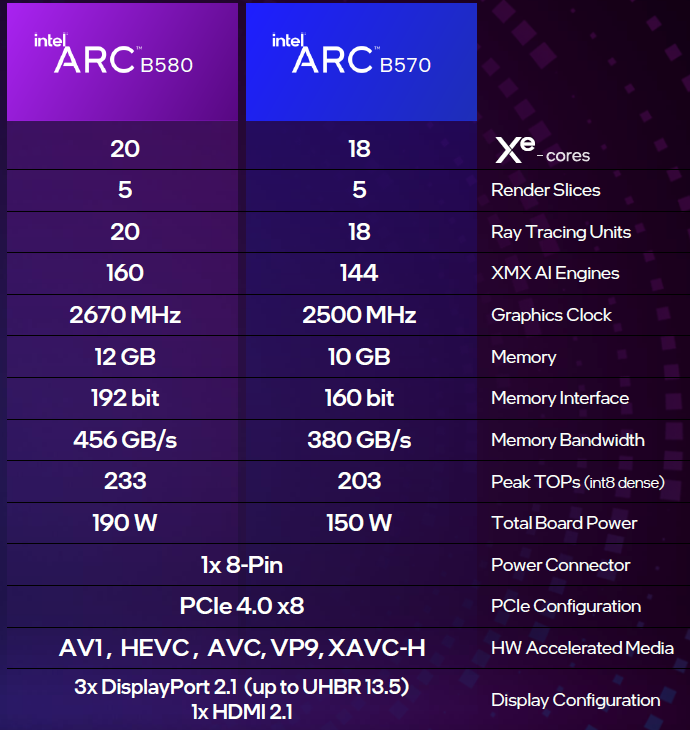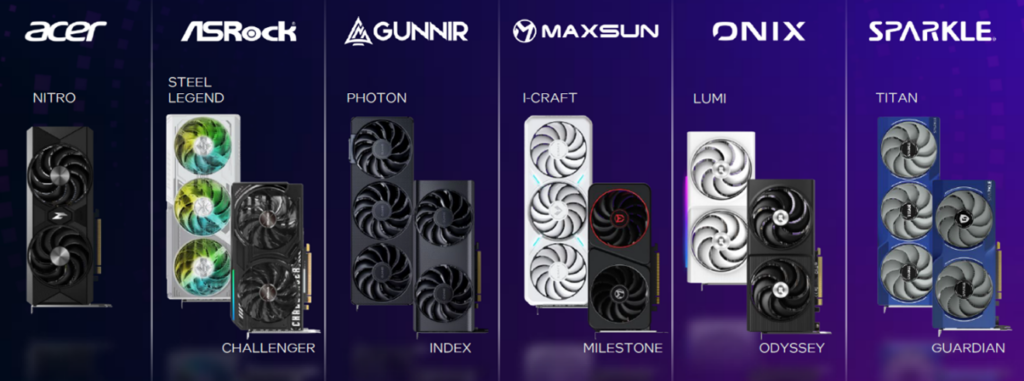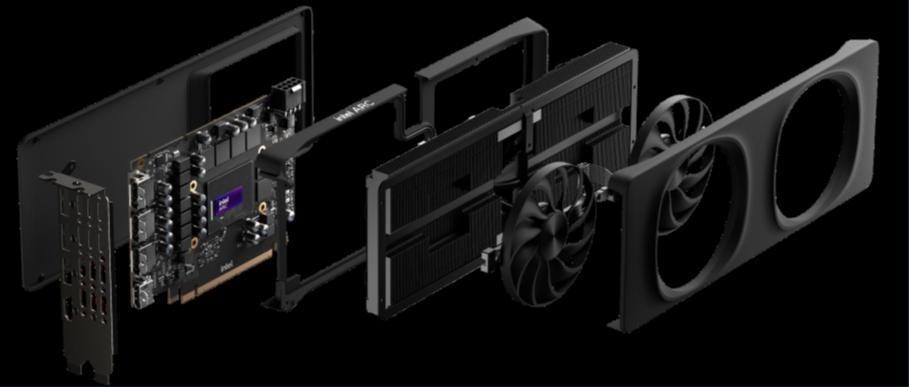Intel has announced its new Intel Arc B-series graphics add-in boards, formerly code-named Battlemage. The new GPUs, B580 and B570, offer improved performance and value, featuring modern gaming capabilities, AI acceleration, and Intel Xe Matrix Extensions (XMX) AI engines. They have Intel’s latest Xe2 architecture, improved efficiency, and higher execution per core. The GPUs provide high-performance gaming at 1440p Ultra-quality settings and show significant improvements in this area over the previous generation.

Intel has announced its new Intel Arc B-series graphics add-in boards, formerly code-named Battlemage. This is the long-awaited second generation in Intel’s Arc product line, and the company says it offers improved performance and value.
There are two new GPU SKUs, the B580 and the B570. They feature modern gaming capabilities, AI acceleration, and Intel Xe Matrix Extensions (XMX) AI engines. The engines power Intel’s second-generation XeSS upscaling, which includes three technologies to increase performance, visual fluidity, and responsiveness.
The Intel Arc B-series GPUs have Intel’s latest Xe2 architecture, and the company claims they offer improved efficiency and higher performance per core. They include ray-tracing units, improved mesh shading performance, and so-called key graphics functions.
XeSS 2 includes XeSS Super Resolution, XeSS Frame Generation, and Xe Low Latency. These technologies work together to increase frames per second (fps) and improve game responsiveness. Intel says the Arc B-series GPUs offer improved performance per Xe-core and performance per watt compared to the previous generation. The company also says the new GPUs provide great gaming performance at 1440p Ultra-quality settings.

The individual 2nd-gen Xe-core has eight SIMD16 processors and can be set up in a variety of configurations.

The SIMD’s ALUs are stacked up to form a vector engine useful for graphics and AI training.

Since 2018, the new normal for GPUs and graphics AIBs has been the ability to perform real-time ray tracing. The solution has two parts: a sufficient number of interesting engines, commonly referred to as ray-tracing units, and AI-based supersampling software, which, in Intel’s case, is branded as XeSS.

Putting all the pieces together, an SoC is formed, and a new name is created.

Intel says the Arc B-series GPUs show significant performance improvements over the previous generation. They offer 70% improved performance per Xe-core and 40% increased performance per watt. Specifically, the B580 GPU is faster than the Intel Arc A750 GPU, with some games seeing substantial speed increases.
Intel offered some comparative data of how much the B series’s performance is an improvement over the A series.

The Battlemage AIB will initially be offered in two versions—the B580 and the slightly smaller B570. The general specifications for the AIBs are shown in Figure 7.

The AIBs have 12GB or 10GB of GDDR6 memory chips that run at 19 Gbps, but could be overclocked to 20 Gbps. The base GPU clock can be raised up 200 MHz, and the voltage to the GPU can be raised by 25%, which will put the GPU clock on the B580 up to 310-plus MHz—which is a significant overclocking and, of course, not recommended—and will vary from unit to unit.

Intel also ran some benchmarks, as would be expected, and compared the B580 to an AMD RX 7600 and Nvidia’s RTX 4060. And, the Intel B580 out-performed both AIBs in raster and ray-tracing tests.

A half dozen AIB suppliers will be the initial partners to offer the new B580 AIB, which is on sale starting December 12, 2024, for $249.

The slightly smaller B570 will be available in mid-January for $219. Intel has positioned these midrange AIBs at an entry-level price.
Intel has also developed some new software tools for developers and OEMs so they can fine-tune the GPU to meet their specific differentiation ambitions. One such example is the Frame Analysis tool.

The company also has a new and expanded SDK with Vulkan and DirectX 12 compatibility.
Three major additions or improvements have been made to the second-generation XeSS: super-resolution, frame generation, and a dynamic low-latency function.
Latency from the user’s action to the screen’s reaction can impact gameplay, introduce stutter, and even impact competitive gameplay.

Intel has developed delaying techniques to keep user actions in sync with the screen’s results. This simple-to-describe but tricky-to-accomplish technique will keep the pipeline steady, regardless of render times.

The results speak for themselves, as illustrated in Figure 14.

End users will find a settings menu in the driver package that will allow them to adjust the delay or turn the feature on and off along with VSync.
The company has also developed a latency measurement tool (LMT) testing device for OEMs and developers that allows fine-tuning for specific applications.
Intel also has some bragging rights with their new XMX engine for LLM applications and training. Some AI frameworks make use of different processor types, as shown in Figure 15.

As a result, Intel claims significant improvement in LLM execution of Nvidia’s RTX 4060.

Intel’s expanded UI gives the user access to display settings, 3D graphics settings, performance overclocking and controls, latency settings, and more.

Battlemage? A Battlemage is a term used in fantasy fiction, particularly in role-playing games and fantasy literature. A Battlemage is a powerful magician who specializes in combat magic, combining magical abilities with martial prowess.
The Intel Arc B580 and B570 are the latest instances of the Xe2 architecture, which has already come to market as part of the Intel Core Ultra V-series CPUs, featured in notebooks and handheld gaming machines.
We’ll be testing this new AIB this week and hope to have some results soon.